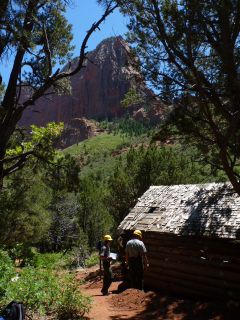
ZION NATIONAL PARK – This week Zion National Park is embarking on a unique project to stabilize two log cabins within its designated wilderness. The two cabins, built in 1929 and 1930, pre-date the park’s acquisition of the Kolob Canyons section of the park.

“The park feels very strongly that it should preserve local culture as well as the natural landscape,” said Jock Whitworth, park superintendent. “The two ideas are not exclusive. These cabins are some of the best tangible remains of the area’s homesteading tradition.”
The two cabins were built by Southern Utah State College – now Southern Utah University – professors, who also had homes in nearby Cedar City. The families came to Kolob Canyons seasonally to graze their sheep and goats along the Middle Fork of the Taylor Creek.
“The cabins are actually in pretty good shape considering they are over 80 years old, but we need to repair the roofs and replace a few logs to ensure they continue to withstand the winters,” Whitworth said.
“Located within designated wilderness, makes stabilizing these two cabins challenging” he said. “To preserve the wilderness character of solitude and naturalness for wilderness visitors, no wheeled vehicles, not even wheelbarrows, are used. Neither are motorized tools.”
Everything must be done by hand or with hand tools, including carrying in lumber and shingles to fix the roof and felling a few trees with crosscut saws to replace rotted logs. Construction techniques will be similar to those the homesteaders would have used.
“This means a lot more work but also makes it a lot more rewarding,” said Dan Rhode, park archeologist. “You gain a lot more respect for what the homesteaders did.” For example, one log took ten people to move.
Zion National Park’s cultural resource staff was joined by an American Conservation Experience crew, a nonprofit conservation corps who bring together American and international volunteers to work on challenging outdoor projects in national parks, national forests, and wilderness areas in the Western United States. The ten person ACE crew provided much needed resources.
“I am not sure how we would have done this without them. They brought a tremendous amount of manpower and enthusiasm to this project,” said Fred Armstrong, chief of resource management.
Southern Utah University, as part of an educational agreement with the park, is documenting the stabilization of the Taylor Creek Cabins. The finalized project is expected to be an eight to 10 minute film exploring Zion National Park’s efforts to balance the needs of the Wilderness Act and the National Historic Preservation Act. “These two mandates can seem to be contradictory, but with a little creativity and by sometimes going back to the basics, we can and must meet both,” Whitworth said.